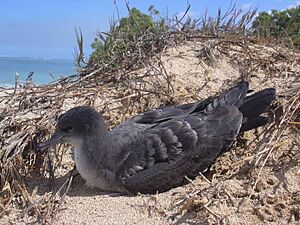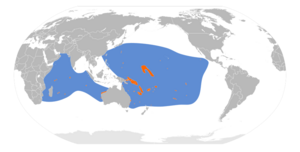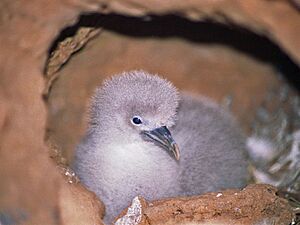Wedge-tailed shearwater facts for kids
Quick facts for kids Wedge-tailed shearwater |
|
|---|---|
 |
|
| Conservation status | |
| Scientific classification | |
| Genus: |
Ardenna
|
| Species: |
pacifica
|
 |
|
| Nonbreeding Breeding | |
| Synonyms | |
|
Procellaria pacifica (protonym) Puffinus pacificus |
|
The wedge-tailed shearwater (Ardenna pacifica) is a medium-sized seabird. It belongs to the Procellariidae family, which includes petrels and other shearwaters. People sometimes call it a muttonbird. Other muttonbirds include the sooty shearwater and the short-tailed shearwater.
You can find the wedge-tailed shearwater in warm parts of the Pacific and Indian Oceans. It lives between about 35°N and 35°S latitude. These birds make their nests on islands near Japan, Hawaii, the Seychelles, and Australia. They also breed on the Islas Revillagigedo and the Northern Mariana Islands.
Contents
About the Wedge-Tailed Shearwater
The wedge-tailed shearwater is the biggest tropical shearwater. It comes in two main colors: dark and pale. Pale birds are more common in the North Pacific. Dark birds are found more often in other areas. Both colors can be found in all groups of these birds. The color does not depend on if the bird is male or female. It also does not depend on if they are breeding.
The pale birds have grey-brown feathers on their back, head, and upper wings. Their belly is whiter. Darker birds are grey-brown all over their body. The bird's name comes from its tail, which looks like a large wedge. This tail might help the bird glide when it flies. Its beak is dark, and its legs are pink. The legs are set far back on its body. This helps the bird swim well, like other shearwaters.
This bird is related to Buller's shearwater. Buller's shearwater looks different in color. However, it also has a wedge tail and a thin, black beak. These two birds are part of a group called Thyellodroma. This group includes large shearwaters.
What Wedge-Tailed Shearwaters Eat
Wedge-tailed shearwaters find their food in the open ocean. They eat fish, squid, and small crustaceans. About 66% of their diet is fish. Goatfish are a common type of fish they eat.
People used to think these birds mostly ate food from the water's surface. But observations showed they often snatch prey while flying close to the water. This is called "contact-dipping." A study in 2001 used special devices to track how deep they dived. It found that 83% of these birds dived to find food. They usually dived about 14 m (46 ft) deep. Some could even dive as deep as 66 m (217 ft).
Wedge-Tailed Shearwater Reproduction and Life Cycle
Wedge-tailed shearwaters nest in large groups called colonies. They choose small tropical islands for their nests. The time they breed changes depending on where they live. Birds in the Northern Hemisphere start breeding around February. Birds in the Southern Hemisphere start around September.
These birds return to the same colony where they were born to breed. They usually start breeding when they are four years old. Wedge-tailed shearwaters stay with the same partner for many years. If a pair does not successfully raise a chick, they might find new partners.
They build their nests in burrows (tunnels in the ground). Sometimes they nest on the surface under plants or rocks. Both parents help dig or fix the burrow. They also use burrows made by other bird species. For example, in Hawaii, the Bonin petrel breeds at a different time. This helps them avoid the wedge-tailed shearwaters. If Bonin petrel chicks are still in their burrows when wedge-tails return, the chicks might be harmed.
These birds usually visit their colonies at night. However, non-breeding birds are often seen during the day. Breeding birds might rest outside their burrows before laying an egg.
Both male and female birds leave the colony before laying an egg. They do this to build up energy. This trip usually lasts about 28 days. The female lays only one egg. If this egg is lost, they will not try to lay another that season. The male usually sits on the egg first. Both parents take turns incubating the egg. Each turn can last up to 13 days. The egg hatches after about 50 days.
After the chick hatches, a parent stays with it for up to 6 days. This helps the chick stay warm. After that, the chick is left alone in the nest. Both parents then go hunting for food. At first, they feed the chick "stomach oil." This is an oily, energy-rich food made in the parent's stomach. Later, they feed the chick solid food and stomach oil.
Parents take turns on long and short trips to find food. They might take short trips (1–4 days) and then long trips (about 8 days). This helps them coordinate feeding their chick. Chicks grow very big, sometimes weighing more than the adult birds. Then they lose some weight before they are ready to fly. Chicks leave the nest after 103–115 days. After this, they can take care of themselves.
Some known breeding colonies include:
- Pacific Missile Range Facility, Kauai, Hawaii
- Heron Island, Australia
- Lady Elliot Island, Australia
- Lady Musgrave Island, Australia
- Lord Howe Island, Australia
- Montague Island, Southern New South Wales, Australia
- North West Island, Australia
- Muttonbird Island, Coffs Harbour, Northern New South Wales, Australia
- Mānana Island, Hawaii, United States
- Maui, Hawaii, United States
- Mokuauia Island, Hawaii, United States
- Kupikipiki’o Pt., Hawaii, United States
- Ilot Maitre, Noumea, New Caledonia
- Round Island, Mauritius
- Ka'ena Point, Oahu, Hawaii
- Mañagaha, Saipan, CNMI
- San Benedicto Island, Revillagigedo Islands, Mexico
- Alphonse Island, Republic of Seychelles
- Bijoutier Island, Republic of Seychelles
Images for kids
See also
 In Spanish: Pardela del Pacífico para niños
In Spanish: Pardela del Pacífico para niños







